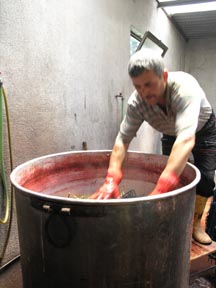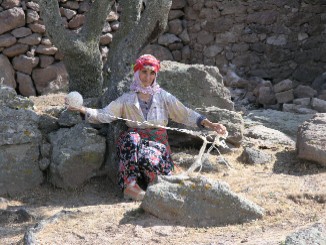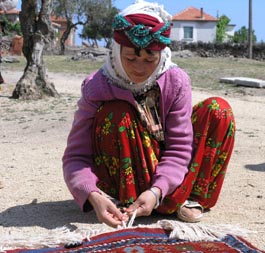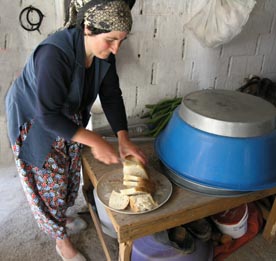
![]()
GROUP
JOURNAL FOR
earlham collEge - handS on craft tour
May 10, 2005 - June
01, 2005
|
GROUP
JOURNAL FOR |
| Day 18 May 27, 2005 Assos The text and the picture is submitted Christine M. Larson e-mail: larsoch@earlham.edu |
   |
|
We had a relaxed morning at our hotel right next to the Aegean Sea in the town of Kucukkuyu. After breakfast, Sandy gave us a short presentation on the DOBAG weaving and dyeing cooperative that we’re visiting today. Then, we had a little free time and some of us reviewed and discussed kilim, soumak, and cicum weaving techniques. We went to the center for the DOBAG cooperative in Ayvacik. DOBAG is an acronym for a Turkish title for a natural dyeing project. The project began in the early 1980s with the leadership of Harald Bohmer, to gather and preserve knowledge about the natural plant dyes used by Turkish weavers for centuries. Today the cooperative has over 300 members in more than 30 villages in the region. At the cooperative headquarters, the head of the co-op, Mustafa Fanzun, told us about the history, the dyes, and the impact on the villages. Besides preserving knowledge about dyes, the coop has enhanced the economic conditions and stability of the villages by providing independence and income, keeping workers in the villages (as opposed to their moving to larger cities for work), and increasing the economic power of the women. (The women do most of the weaving, and do it in their homes.) Mustafa told us about the plants used in dying, and we saw a demonstration at the shop out back. In huge aluminum pots on big gas burners, the dyer puts the dried plant matter and the spun wool. The wool used is “yapak,” the first shearing after winter, which is stronger and softer wool. Madder root is used for red, chamomile or digitalis for yellow, indigo for blue, and acorns for black. The acorns used come fro the Trojan Oaks of the region, and are the biggest acorns I’ve ever seen. The DOBAG dyers also make purple, but the recipe is a secret. All the carpets contained bright and rich colors, and were soft underfoot. We left the headquarters and went to a village where we had a homemade lunch on the patio of the mosque. We visited the home of one of weavers at work, then went to Mustafa’s home and met his wife Fatma, who is another coop weaver. We then went to another village and visited the home of a young woman recently married. She showed us many of the hand-made items of her dowry, and her wedding dress. As a married woman of this village, she now wears the traditional red head-scarf with sequins on the edge. We briefly visited a school, although the children had left for the day by the time we got there. The classroom had postings of the Turkish national anthem, weather charts, maps, English phrases the students were studying, and the Turkish pledge of allegiance. It was interesting to note that the pledge was entirely secular, and included phrases about being an honest and hardworking citizen. We went to a lovely village for dinner, where we ate in a restaurant with a view of the mountains. Afterwards, we gathered in the lounge to say goodbye and thanks to Meli, who leaves us tomorrow to lead another tour. Meli has been wonderful to us, and we love Turkey! After tears and hugs and sharing memories, we returned to the hotel. |
||
|
Top |
Next |
|